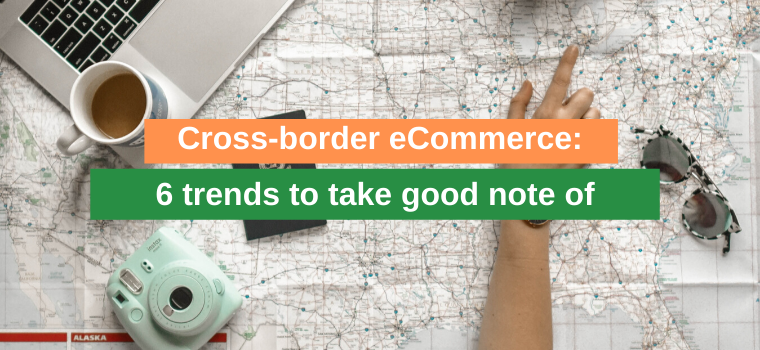Are you looking forward to reaping the full benefits of cross-border e-commerce? Well, if you are, you have come to the right place. Keeping up with many e-commerce changes is sometimes hard. And it might become a real pain in the neck. However, this article will ease you into one of these changes, cross-border e-commerce trends.
The majority of the world’s population has become accustomed to this type of business model. A large percentage actually prefers cross-border e-commerce over the not so much fun native way of doing business restricted by geographical factors.
Surprising, isn’t it?
Now, that cross-border e-commerce has already proven its efficiency, it is time to crank up the heat.
But wait, how do you do that?
It is quite simple. Keep up with the latest cross-border e-commerce trends. The trends help you stay on top of the game and leave your competitors a few steps behind every time. Creating room for cross-border e-commerce trends is just what you need. Without further ado, let us explain these trends in-depth to you.
Six cross-border e-commerce trends to expect in 2020
1. Explosive Internet connectivity growth
One of the major cross-border e-commerce trends with a huge impact on the international e-commerce scene is the growth of Internet connectivity. Globalization and the fact that people are more tech-savvy have played a great role in this. In fact, Invesp reports that 54% of Americans shopping online reported making purchases from a foreign site in the past.
Today, there is a high number of mobile users, particularly smartphone users, who spend a substantial amount of their time online. Companies should, therefore, take advantage of this fact and make sure that in the next few years, they will be among the beneficiaries of the new trend. Thus, Internet connectivity growth is the first on our list of cross-border e-commerce trends.
2. Online shopping
On top of the increased number of smartphone users, consumers have a taste for shopping abroad. For starters, the digital era has made it possible to shop online paving way for international e-commerce and a variety of other options. With that in mind, a variety of products are available online. And in many cases, it’s cheaper to purchase them online than locally.
As a result, cross-border e-commerce trends of 2020 require merchants to optimize their businesses online. The behavior has manifested itself through a rise in international purchases and the number is still rising. Banking on this, it will be easier to evaluate and set the necessary strategies to have your site mobile-optimized to attract more sales.
3. Making it “local”
Yes, you read that right! Businesses that are making their services and products “local” manage to be giants in cross-border e-commerce. Why is this so? By offering your brand to global consumers in a manner that makes the experience very easy and dependable, you win the consumers hearts. Making it local will require commitment and investment in order not to fail your consumers.
You might also like “12 best open source e-commerce platforms for your business”
Soon, the cross-border e-commerce world will be congested and making it “local” will be an added advantage. Brands are yet to fully achieve this hence creating a precious opportunity. There is no doubt that in the next few years, it is one of the cross-border e-commerce trends to watch out for.
By the way, while still on the subject of trends, check out our article on seven major travel payment trends you as a merchant should also remember about!
4. Payment options
Consumers will often go for the most convenient way when it comes to payment options. Believe it or not, once you eliminate the issue of verification delays and hidden transaction costs, your turnover will hike up enabling you to improve your services. Credit cards are a reliable form of payment option but they do not make it all smooth sailing. Today, third-party payment platforms are among the cross-border e-commerce trends to embrace.
Do not give consumers a chance to discard their items added to the cart due to poor payment options. Incorporate local currency and the most preferred payment choice by locals in your online shop through various third-party platforms. This way, for instance, you’ll be able to ensure satisfaction and faster money transfer services. Follow suit to secure a position in the new cross-border e-commerce world.
5. Local customs and culture
Let’s face it, a clear insight into local customs and cultures is a huge confidence booster in cross-border e-commerce. You will want to pay attention to such cross-border e-commerce trends as they are key to having the conversion rates skyrocket. Setting up a shop and waiting for the magic to happen is a no-no!
Before going through with any cross-border e-commerce marketing strategy, make sure you understand the local culture. This way you will come up with irresistible international online shopping offers and events that will play well for the company’s goals.
6. Transparency
The basic rule of the thumb for any business is putting the customers first. A slight provocation of customer dissatisfaction can be your business’ downfall. In cross-border e-commerce, being open sets the mood. Any additional charges should be made known to the consumers.
When currency rates change, be sure to update your prices accordingly. Consumers are aware of such cross-border e-commerce trends and are only opting for cross-border e-commerce businesses with well-outlined terms of trade. Still not sure whether you really need it? The cross-border e-commerce trends tackle the challenges associated with international online shopping.
You will have a clean slate with the local law. Different countries have different rules when it comes to specific goods and services. They depend on numerous factors from legal age limit to the legalization of these products. E-commerce is not an exception to such regulations. That is why sticking to the above-mentioned cross-border e-commerce trends will keep you in good terms with the local law enforcers.
You might also like “Shopify VS WooCommerce: What’s best for your business”
Besides, keeping up with these cross-border e-commerce trends solves trust issues. And one can’t underestimate the significance of this aspect in online shopping. Adhering to transparency and reliable payment options clear all doubts surrounding the e-commerce world. Also, the cross-border e-commerce trends iron out some barriers such as those brought about by language differences.
7. Race to the bottom.
Apart from all the other reasons we’ve mentioned above, we’re also expecting to see an increased interest in the products from the developing countries’ markets. In fact, Invesp states that 67% of all global shoppers opt to buy from a foreign market because the prices there are typically lower than in their own country. And these numbers will keep on growing.
So far, clothing, accessories, books, and toys top the list of products most purchased on the foreign markets.

Over to you
We’ll be wrapping up for today. The only thing we can’t but mention is that taking cross-border e-commerce trends into account will solve inconsistency challenge. Moving with the current trends makes it easy for e-commerce businesses to adapt to the changing market and still deliver their promises while remaining relevant.
Cross-border e-commerce is what you make it be. Do not make it unbearable both for your business and the consumers. Just stick to what you do best and keep an eye on cross-border e-commerce trends to be ahead of time and competitors. Success in this industry is your choice.
Next week, we’ll talk about sharing and on-demand economies. Be sure to subscribe to our news not to miss our valuable insights!






